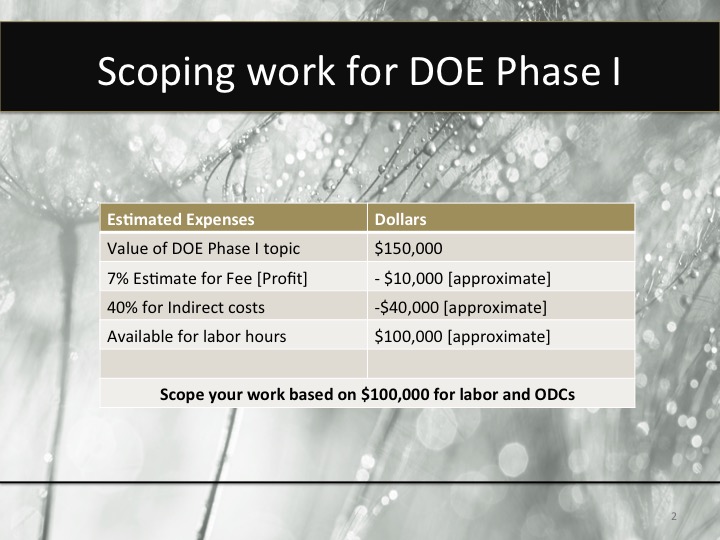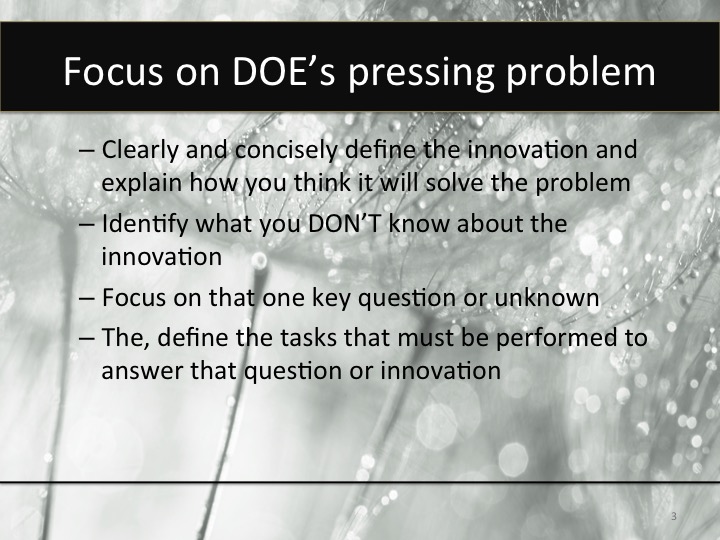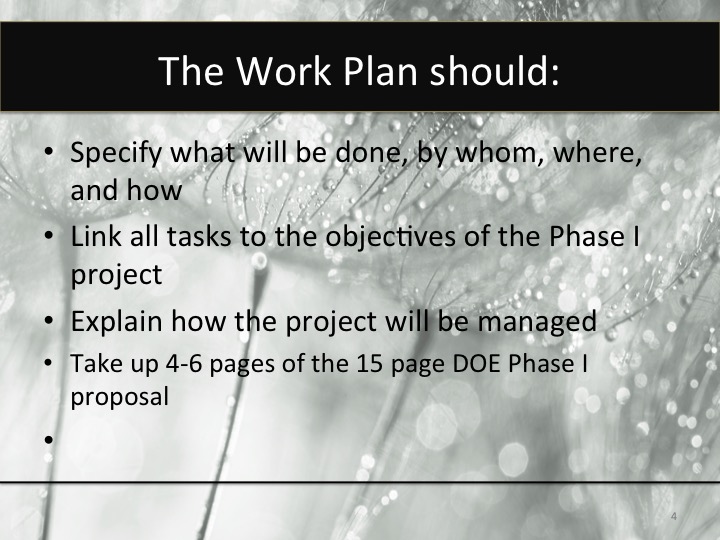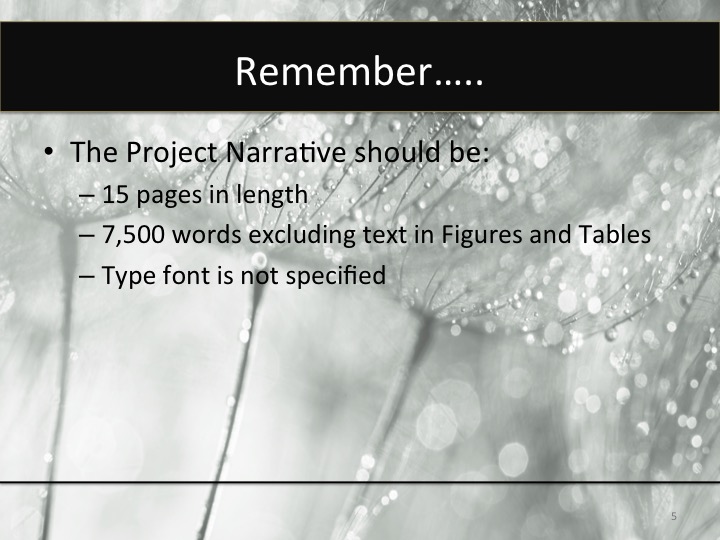Tutorial 22:
What are the Elements of a Good DOE Work Plan?
The Work Plan is the heart of a Department of Energy SBIR/STTR proposal. It tells the program manager and reviewers how you will do the research, and what you will do in return for the $150K to $225K you will receive to conduct the Phase I research. Your work plan should evolve from two important but very different considerations as you are developing your proposal.
First, the work plan needs to reflect the budgetary limits stipulated by the Department of Energy. SBIR/STTR applicants are constantly guilty of submitting “overly ambitious work plans.” To avoid this common mistake, it is suggested that you scope the proposed project based on the available funds. You will be able to determine this by looking at the header above each topic listed in the DOE Topics document. Start with the maximum allowed by DOE—let’s assume the maximum is $150,000 for your particular Phase I topic. First determine what percentage you need to deduct from this amount to cover the profit/fee that all agencies allow you to request—and you should request it. This is the most flexible money you receive as it can be used to cover unanticipated expenses, or costs that the agency considers “unallowable” per the Federal Acquisition Regulation (FAR) or other restrictions. Let’s assume you determine that 7% is an adequate fee; 7% percent of $150,000 is about $10,000, so now you have $140,000 left. Next remove a portion of that amount to help cover your general costs of being in business, known as indirect costs, overhead, general and administrative (G&A). The rate you use should be estimated specifically for your company for the time frame when the SBIR/STTR project will be performed. For sake of this discussion we will assume it equals 40% of your costs of doing the project research. This means another $40,000 should be deducted, so now you have a remainder or $100,000. This is the amount you have to actually perform the Phase I research, including your labor and materials, and the cost of any consultants or subcontractors who will help you conduct the technical work. Put another way, even though the agency is willing to fund a $150,000 SBIR/STTR project, you only have in this example about $100,000 to conduct the research itself, with the balance used to cover the costs of being in business and your profit/fee.
The Second consideration is that the work plan must focus on your solution to the DOE’s pressing problem. In Phase I, you are expected to prove that your innovation “works” and is a viable solution to the problem of interest to the Department of Energy. This process is referred to as “proving the feasibility” of your unproven innovation. You must clearly and concisely define the innovation and explain how you think it will solve the problem. Next, identify what you don’t know about the innovation’s ability to solve the problem. Focus on that one “key” question or unknown – the one on which the whole innovation hinges. Next define several objectives that will lead you to answer that one question. Finally, specify the tasks that you must perform in Phase I to meet the objectives and, in turn, answer the question regarding the viability of your solution.
The “intersect” between the budget and these tasks is what becomes the work plan. You propose a series of tasks that you can afford to perform given the limited Phase I budget, and that will allow you to answer the key question and conclude whether your innovation is a feasible solution to the Agency’s problem.
The DOE defines in its Funding Opportunity Announcement (FOA) what it expects to see in your work plan and offers the following guidance in Part IV(c) of its Phase I FOA:
- The work plan should be a substantial portion of the overall Project Narrative
- It should specify what will be done, by whom, where, and how
- It should link all tasks to the objectives of the Phase I project (which should be specified in the preceding section of the narrative)
- It should explain how the project will be managed, which is especially important if the small company applicant is teamed with large entities and/or with subcontractors that are doing large portions of the work (e.g., up to 60% of an STTR project can be done by a university or FFRDC)
The Department of Energy expects the work plan to be detailed—the DOE FOA instructions state that you are to provide “an explicit, detailed description of the Phase I research approach and work to be performed.” Keep in mind that the work plan is one element of the Phase I Project Narrative and it is recommended that at a minimum, you devote 4-6 pages of a 15 page DOE Phase I Project Narrative to the work plan. Also keep in mind that there is a 7,500 word limit. Please note that the word limit applies to the text in the body of the Project Narrative and does not include words in tables and graphs. Also, sections such as the budget, budget justification, key personnel, and commercialization plan should not be included in the Project Narrative but attached in the appropriate fields for those forms.
To make sure you provide adequate depth and detail in your work plan, go beyond explaining “what” you plan to do in your Phase I SBIR/STTR project, by going on to thoroughly explain “how” you are going to do each task. And don��t forget to indicate “who” will perform each task and “when” it will be done in the Phase I project period.
Indicating “when” the work will be done suggests that a timeline should be included. With some agencies, a timeline is appropriate within the work plan. However, Part IV(c) of the DOE FOA suggests that the timeline should be included immediately after the work plan in your Phase I Project Narrative. You may want to include the timeline as a graphic (9 columns, 1 for each month of the Phase I, and a row for each of the tasks proposed in the work plan), and not as a narrative so the reviewer can more easily see the flow and progression of the proposed project.
While the work plan is an important component to any SBIR/STTR proposal, it is especially valuable when the applicant company is new to SBIR/STTR or at least to this agency and its reviewers. The work plan should show the applicant’s capability for performing the research. If the work plan is detailed, and the tasks and flow of work is logical to the reviewers, then they will be inclined to conclude that the applicant is able to do the work. If the work plan is vague and/or illogical, then the reviewer may question the applicant’s qualifications or ability to perform research, which may result in a low scored proposal.
Successful completion of the work plan should be measurable so that both the small business applicant and the DOE will know when the project was completed and whether the proposed innovation is a viable solution to the problem. This measurement can be made in two ways. First, along with a statement of what must be done to prove the feasibility of the innovation, the applicant should specify how success will be determined. It should be quantified, and should state (as an example) a threshold value that must be achieved to conclude the innovation provides a feasible solution. The objectives and work plan then need to lead to the generation of data, results, and conclusions that can be used to measure feasibility success. Second, successful completion of the work plan can be measured by showing that all of the specified tasks have been completed.
Quiz: Module 22: What are the Elements of a Good DOE Work Plan?
1
A work plan should be as vague and general as possible to give the small business maximum flexibility to do whatever it feels like doing.
Nice Work
Try Again
2
Which of the following statements is NOT accurate?
Nice Work
Try Again
3
Write the work plan first, and then figure out how much it will cost to do the work. You can then cut back or eliminate the profit/fee and indirect/F&A costs to give you enough money to do all the work.
Nice Work
Try Again
4
A detailed work plan helps the agency and its reviewers conclude that the applicant knows what it is doing, even if the applicant is new to SBIR/STTR.
Nice Work
Try Again
5
A timeline isn’t needed because the reviewers just care that you include a sworn statement that you will finish the research on schedule.
Nice Work
Try Again




